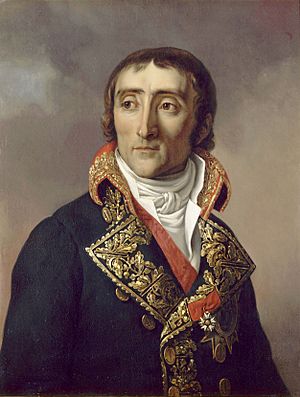Étienne Eustache Bruix facts for kids
Quick facts for kids
Étienne Eustache Bruix
|
|
|---|---|

1837 portrait by Guérin
|
|
| Born | 17 July 1759 Fort-Dauphin, Saint-Domingue (present-day Haiti) |
| Died | 18 March 1805 (aged 45) Paris, France |
| Allegiance | |
| Service/ |
Navy |
| Years of service | 1778-1805 |
| Rank | Admiral |
| Battles/wars | French Revolutionary Wars (Ireland), Napoleonic Wars |
| Other work | French Naval Minister |
Étienne Eustache Bruix was an important French Navy officer. He became an admiral and even served as the Minister of the Navy. He was born in Fort-Dauphin, Saint-Domingue (which is now Haiti) on July 17, 1759. He passed away in Paris, France, on March 18, 1805.
Contents
Étienne Eustache Bruix came from a family in Béarn, France. He began his sailing journey as a volunteer on a trading ship.
In 1778, Bruix officially joined the French Navy. He started as a Garde-Marine, which is like an officer cadet. He served on several frigates, which are types of warships.
He took part in many important naval battles. These included the Battle of Fort Royal in 1781 and the Battle of the Chesapeake later that year. He also fought in the Battle of Saint Kitts and the Battle of the Saintes in 1782. Because of his good service, he was promoted to Ensign in November 1781.
First Commands
Bruix was given command of a small 10-gun ship called the Pivert. His job was to explore and map the coasts and harbors of Saint-Domingue. He worked with another officer named Puységur on this task.
In May 1786, Bruix was promoted again, becoming a Lieutenant. He also became a member of the Académie de Marine in 1791. On January 1, 1793, he was promoted to Captain and given command of the 80-gun ship Indomptable.
However, he was later removed from service in October 1794. During this time, he wrote a paper about how the French navy could get supplies only from within France. This idea was noticed by the Navy Minister, Laurent Truguet. In 1795, Bruix was called back to duty. He was given command of the 74-gun ship Éole. Later, he became the Chief of Staff for Admiral Villaret-Joyeuse's squadron.
In 1796, Eustache Bruix commanded a group of ships under Admiral Justin Bonaventure Morard de Galles. This was during a French attempt to invade Ireland. Lazare Hoche, a famous general, noticed Bruix's skills during this campaign. Hoche promoted him to contre-amiral (Rear Admiral) in May 1797.
Soon after, on April 28, 1798, Bruix was appointed as the Navy Minister.
The Mediterranean Expedition
As Navy Minister, Bruix quickly went to Brest, a major French port. He took personal command of a large fleet. This fleet was meant to sail to Egypt to help the French army that was stuck there.
Bruix's fleet managed to avoid the British ships blocking the port. He sailed south with 25 large warships. The British thought he might be heading to Ireland, so they sailed northwest. This gave Bruix a good head start. Near Cádiz, Spain, Bruix saw a British fleet of 15 ships. Even though he had more ships, Bruix decided not to attack. He continued into the Mediterranean Sea.
Bruix stopped in Toulon for repairs. He then received news that General André Masséna was surrounded in Genoa, Italy. Bruix was ordered to help him. He tried to sail his fleet to the Gulf of Genoa to deliver supplies. However, bad weather forced him back. Meanwhile, the British fleet, led by Lord Keith, had followed him into the Mediterranean.
Bruix decided to abandon his mission to Genoa. He cleverly avoided the British ships and returned to the Atlantic Ocean. He then met up with a Spanish fleet and sailed back to Brest. This journey became known as the Cruise of Bruix.
After this long expedition, Bruix resigned as Minister of the Navy on July 11, 1799. He then took command of a fleet gathered at île d'Aix, ready to sail to Spain. However, the British strengthened their blockade. Bruix also became ill, and a peace treaty, the peace of Amiens, stopped the fleet from leaving port. He was promoted to Vice-amiral on March 13, 1799.
Later Career and Death
Bruix was aware of the secret plan for the coup d'état of 18 Brumaire (November 9, 1799). This was when Bonaparte took power in France. After becoming leader, Bonaparte promoted Bruix to admiral in 1801. The next year, he was appointed as a Conseiller d'État, which is a high-ranking advisor.
When war started again, Napoleon planned a new invasion of England. He put Bruix in charge of the fleet of small boats based at Boulogne. These boats were meant to carry the invasion troops across the English Channel.
Bruix worked hard on this project. However, in July 1804, he refused to obey Napoleon's direct order. Napoleon wanted the fleet to go out for a review, but a storm was developing. Bruix knew it was too dangerous. The Emperor was furious and almost hit him. Another officer carried out Napoleon's order, but about 200 lives were lost because of the storm.
After this incident, Bruix became very ill. He had to return to Paris. He died there from tuberculosis at the age of 45.
Legacy
A street in Paris, Boulevard de l'Amiral-Bruix, is named in his honor.

